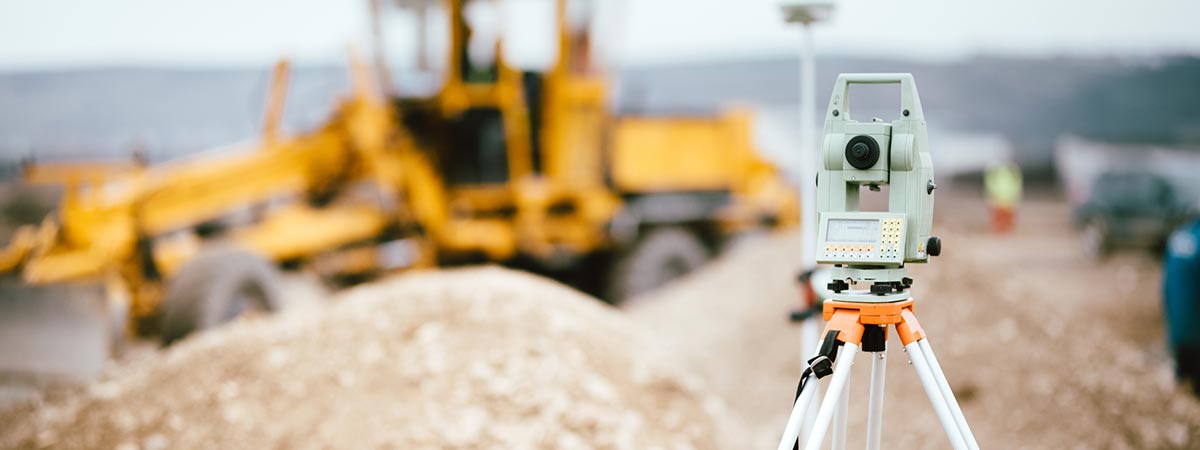What is a Total Station in Surveying Equipment?

A total station (TS) is an electronic and optical device that is commonly used in surveying. Because of it’s somewhat mysterious name, we figured we might as well create a blog that talks about your common surveying total station, what it is, what it does, and more.
What Exactly is a Total Station?
A total station is a piece of surveying equipment that consists of an electronic transit theodolite integrated with electronic distance measurement technology. This allows a total station to accurately measure both vertical and horizontal angles from the device to a designated point in the distance. These devices user computers to collect that data and perform all the necessary measurement calculations.
Total Stations are aligned towards the object by an operator who points it at the intended object using a telescope. Once the target object is aligned in the cross hairs, the total station will automatically measure all distances and angles from the point by automatically turning on top of a tripod, recording all those measurements and making them available to the operator.
They’re extremely useful when surveying sites and gathering data. With manual total stations, you’ll have one operator at the TS and the other holding a reflective sensor. For each measurement, the TS operator has to align the reflector in the telescope cross hairs.
With an automatic total station, the surveying job can be done with only one person on the ground as the total station will automatically find the reflective sensor and align itself.
A survey equipment total station has four main functions:
Angle Measurement
Total stations use complex optical scanning technology to measure highly detailed digital bar codes that are etched on reflective components. This helps the TS orient the distances and angles between physical objects. A high-end total station may be capable of measuring angles down to 0.5 arc-seconds.
Distance Measurement
Total stations use modulated infrared carrier signals to determine the distance between themselves and their target objects. When this infrared light is reflected off a prism or a surveyed object, a total station determines the distance between itself and the reflecting object. Most total stations are dependent on reflective prisms to determine distance, but total stations that don't need prisms are called reflector-less total stations.
Coordinate Measurement
Total stations can use trigonometry and triangulation to determine the coordinates of unknown points. These devices can determine coordinates as long as there is an unrestricted line of sight between a TS and the desired point. Some total stations may also be equipped with Global Navigation Satellite Systems (GNSS) that make determining coordinates even easier.
Data Processing
Some total stations have onboard computers that can perform basic functions, but others are designed to write data to external, handheld computers. In either case, surveying data can be offloaded from a TS onto an external desktop or laptop computer to perform more complex analysis processes.
Can Total Stations Be Operated Remotely?
While total stations are traditionally operated manually, they can also be operated remotely.
A total station that is operated remotely is called a robotic total station, and these types of total stations are usually capable of taking more detailed measurements. A robotic total station can usually be operated from a significant distance.
Once your robotic total station is properly setup over its point, the operator then uses their reflective target and places it at key points of measurement. The robotic total station will scan for the reflective target and lock on allowing the surveyor to tackle a complex survey solo.
What Are the Applications of Total Stations?
Whether you have a Nikon total station or a device that's made by a different brand, there are a number of different applications in which you might use one of these devices. Here are some examples of common applications for TS units:
-
Construction - Since construction is increasingly dependent on building information modeling (BIM), using accurate surveying information from total stations is highly important in this industry. The use of TS units in construction substantially decreases labor costs.
-
Mining - A mining company may use a Nikon total station or a total station made by a different brand to determine the absolute locations of tunnel ceilings, walls, and floors. This information is then processed by CAD programs, which assists mining companies in designing the layout of tunnels.
-
Meteorology - Total stations are also used in meteorology to track the locations of weather balloons. These devices make it easier to determine the movements of weather balloons in upper-level winds. Total stations may also be used in aviation weather forecasting applications, and they can be used to determine the height of cloud layers. Lastly, meteorologists may also use total stations to determine forecasts for rocket launches.
Total stations are amazing pieces of surveying technology that allow surveyors, contractors, and foremen to get accurate measurements and cut down on man hours and chances of inaccuracy in their surveys.
If you would like more information on manual or robotic total stations, get in touch with Superior Instrument today!
|